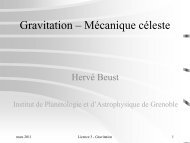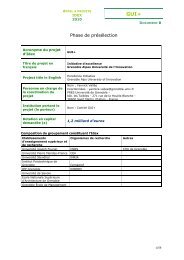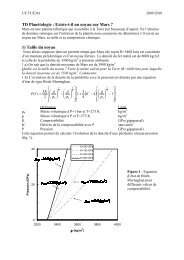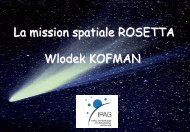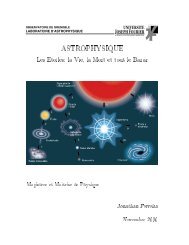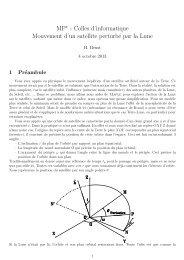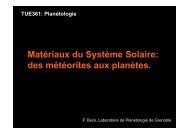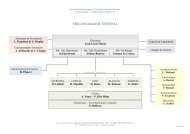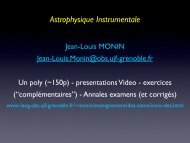The E-ELT Instrumentation Roadmap
The E-ELT Instrumentation Roadmap
The E-ELT Instrumentation Roadmap
You also want an ePaper? Increase the reach of your titles
YUMPU automatically turns print PDFs into web optimized ePapers that Google loves.
<strong>The</strong> E-<strong>ELT</strong> <strong>Instrumentation</strong> <strong>Roadmap</strong><br />
Presentation to the Project Science Team<br />
Suzanne Ramsay<br />
Mark Casali, Norbert Hubin, Hans Ulrich Käufl,<br />
Jean-Louis Lizon, Josef Strasser,<br />
Juan Carlos Gonzalez
<strong>The</strong> instrument studies<br />
• <strong>The</strong> goal of the study programme was to carry-out<br />
a suitable number of instrument studies<br />
‣ to work with the ESO community towards construction<br />
‣ to verify that instruments can be built at an affordable<br />
cost and that they properly address the highest priority<br />
scientific goals,<br />
‣ to work with telescope and operation groups to identify<br />
and define interfaces with the other subsystems and<br />
the observatory infrastructure.<br />
• 9 instrument and 2 post-focal AO studies carried<br />
out by >300 scientists and engineers in 40<br />
institutes throughout the ESO community<br />
E-<strong>ELT</strong> <strong>Instrumentation</strong> <strong>Roadmap</strong> | PST 11.07.2012
OVERVIEW OF THE E-<strong>ELT</strong> INSTRUMENT<br />
STUDIES
Selection process:<br />
criteria<br />
ESO/COU 1275, December 2009<br />
Nr.<br />
Evaluation Criteria for E-<strong>ELT</strong> instrument selection<br />
1 Scientific Merit :<br />
(a) the instrument addresses science goals identified as of highest priority for the E-<strong>ELT</strong><br />
(b) the instrument can be conceived as an E-<strong>ELT</strong> workhorse to be used for a variety of<br />
programmes, leading to a broad spectrum of potential discoveries<br />
(c) the instrument will benefit and complement observations of other major facilities in<br />
astrophysics like ALMA and the JWST , which will be already in operation at the time of first<br />
light<br />
2 Proven Technical Feasibility and Simulated Performance: the instrument feasibility and its<br />
expected performance have been properly demonstrated in the study<br />
3 Affordability: (a) the instrument cost is well estimated and justified (b) the cost to ESO falls within<br />
or close to the preliminary budget envelope.<br />
4 Timely Match to the telescope + PFAO performance: the instrument schedule of implementation is<br />
well matched to the path of the telescope +AO to full performance. <strong>The</strong> instrument includes the<br />
possibility to do prime science even during the time when the telescope cannot operate with AO.
Selection process:<br />
scientific priority<br />
• Science based prioritisation<br />
‣ All instruments candidates for selection at first light with<br />
the exception of the planet camera and spectrograph,<br />
EPICS (highest scientific priority but long technology<br />
development)<br />
• Science Working Group Criteria for selection of first<br />
light instruments<br />
‣ Scientific impact, including certainty of scientific return<br />
‣ Complementarity with other facilities<br />
‣ Scientific Flexibility<br />
‣ Coverage of expected observing conditions<br />
E-<strong>ELT</strong> <strong>Instrumentation</strong> <strong>Roadmap</strong> | PST 11.07.2012
Selection process:<br />
the first light pair<br />
• First light instruments<br />
‣ <strong>ELT</strong>-CAM: NIR diffraction-limited camera with moderate<br />
field size<br />
‣ <strong>ELT</strong>-IFU: NIR IFU spectrograph with optical-IR coverage<br />
and seeing limited to diffraction limited capabilities<br />
‣ Adaptive optics systems as required to meet the science<br />
cases of each instrument<br />
E-<strong>ELT</strong> <strong>Instrumentation</strong> <strong>Roadmap</strong> | PST 11.07.2012
• Primary Imaging Field<br />
‣ 53” across, 3mas pix<br />
‣ 4x4 HAWAII 4RG det<br />
‣ ~20 filter slots<br />
‣ High throughput<br />
• Auxiliary Arm<br />
MICADO:<br />
Diffraction-limited NIR Camera<br />
‣ Imager: 1.5mas & 4mas pixels<br />
‣ Spectrograph: R=3000<br />
‣ 1 HAWAII 4RG detector<br />
• AO System – MCAO/MAORY<br />
PI: Reinhard Genzel (Ric Davies)<br />
MPE, MPIA, USM, INAF-OAPD,<br />
NOVA , LESIA<br />
E-<strong>ELT</strong> <strong>Instrumentation</strong> <strong>Roadmap</strong> | PST 11.07.2012
MAORY :<br />
Multi-conjugate adaptive optics relay<br />
• Multi-conjugate AO<br />
‣ 6 laser and 3 natural guide stars<br />
‣ Deformable mirrors conjugated to atmospheric<br />
layers at 4km, 12.7km<br />
‣ Very high quality images (S.R. >50% in K) over a<br />
wide field - 2‟,<br />
‣ Central 1‟ clear<br />
‣ Two output ports<br />
PI: Emiliano Diolaiti<br />
INAF (Bologna, Padova, Arcetri,<br />
IASF-Bologna), Univ.Bologna,<br />
ONERA<br />
MICADO mounted under MAOR<br />
E-<strong>ELT</strong> <strong>Instrumentation</strong> <strong>Roadmap</strong> | PST 11.07.2012
HARMONI<br />
Single field, wide band IFU, NIR spectrometer<br />
• Wavelength range 0.47-2.45µm<br />
• Spectral resolving power<br />
‣ R ≈ 4000, 10000, 20000<br />
• 4 spatial scales<br />
‣ 4mas, 10mas, 20mas, 40mas<br />
• 4 fields of view<br />
‣ 0.5'' x 1.0'' , 1.25'' x 2.5''<br />
2.5'' x 5'„, 5'' x 10'„<br />
• LTAO/ATLAS<br />
PI: Niranjan Thatte,<br />
Oxford, CRAL, CSIC, IAC,UK<br />
ATC, ONERA<br />
E-<strong>ELT</strong> <strong>Instrumentation</strong> <strong>Roadmap</strong> | PST 11.07.2012
ATLAS:<br />
Advanced Tomographic Laser AO<br />
• Adaptive optics using laser guide stars<br />
‣ Uses the telescope adaptive mirrors, simple design<br />
‣ No additional mirrors in the instrument optical path<br />
‣ Very high quality images (S.R. >50% in K) over ~30‟‟ field<br />
‣ Fixed asterism of six laser guide stars, 2 NGS<br />
‣ Excellent sky coverage<br />
PI: Thierry Fusco<br />
ONERA,GEPI, LESIA, UK<br />
ATC, LAM<br />
E-<strong>ELT</strong> <strong>Instrumentation</strong> <strong>Roadmap</strong> | PST 11.07.2012
Selection process:<br />
planetary camera/spectrograph<br />
• First light instruments<br />
‣ <strong>ELT</strong>-CAM: NIR diffraction-limited camera<br />
‣ <strong>ELT</strong>-IFU: NIR IFU spectrograph with optical-IR coverage<br />
and seeing limited to diffraction limited capabilities<br />
‣ Adaptive optics systems as required to meet the science<br />
cases of each instrument<br />
• A planetary camera/spectrograph with Extreme AO<br />
(>90% Strehl) has high scientific priority and must<br />
be built once the technology is developed<br />
E-<strong>ELT</strong> <strong>Instrumentation</strong> <strong>Roadmap</strong> | PST 11.07.2012
<strong>ELT</strong>-PCS/EPICS<br />
exo-planet imaging camera spectrograph<br />
Integral Field Spectrograph 0.95-1.65μm<br />
FOV: 0.8'' x 0.8'„/2.33mas<br />
0.8'' x 0.014'„ long slit<br />
R = 125, 1400 and 20000<br />
EPOL 0.6-0.9μm<br />
Coronagraphic polarimeter<br />
FOV: 2'' x 2'‘/1.5mas<br />
Contrast ratios – 10 -8 – 10 -9<br />
XAO – very high (90%) Strehl<br />
PI: Markus Kasper, ESO<br />
LAOG,LESIA, Uni. Nice,<br />
LAM,ONERA, Uni.Oxford, INAF,<br />
ETH Zurich, NOVA<br />
E-<strong>ELT</strong> <strong>Instrumentation</strong> <strong>Roadmap</strong> | PST 11.07.2012<br />
12
Selection process:<br />
a pool of capabilities<br />
• First light instruments<br />
‣ <strong>ELT</strong>-CAM: NIR diffraction-limited camera<br />
‣ <strong>ELT</strong>-IFU: NIR IFU spectrograph with optical-IR coverage<br />
and seeing limited to diffraction limited capabilities<br />
‣ Adaptive optics systems as required to meet the science<br />
cases of each instrument<br />
• A planetary camera/spectrograph with Extreme AO<br />
has high scientific priority<br />
• Instruments thereafter of equal scientific priority<br />
‣ A pool of scientific capabilities : MIR imaging and<br />
spectroscopy, VIS-NIR multi-object spectroscopy, VIS-<br />
NIR high resolving power spectroscopy<br />
E-<strong>ELT</strong> <strong>Instrumentation</strong> <strong>Roadmap</strong> | PST 11.07.2012
E-<strong>ELT</strong> <strong>Instrumentation</strong><br />
<strong>Roadmap</strong><br />
• <strong>ELT</strong>-IFU and <strong>ELT</strong>-CAM for first light<br />
(SWG/STC/ESO)<br />
• <strong>ELT</strong>-MIR, MOS, HIRES scientifically equivalent<br />
priorities (SWG/STC/ESO)<br />
‣ Selection by other considerations (project readiness)<br />
• Practical requirements<br />
‣ Staggered project schedule for funding profile<br />
‣ Staggered commissioning schedule<br />
• Start enabling technology development, especially<br />
for high-priority instruments e.g. <strong>ELT</strong>-PCS<br />
‣ Begin project when feasibility (TRL) is demonstrated<br />
E-<strong>ELT</strong> <strong>Instrumentation</strong> <strong>Roadmap</strong> | PST 11.07.2012
<strong>Roadmap</strong> Considerations<br />
• <strong>ELT</strong>-3 to help cover poor IQ conditions (SWG/STC)<br />
• MOS/HIRES scientific requirements to be developed<br />
to allow selection between options (SWG)<br />
• Keep flexibility (SWG/STC/ESO)<br />
‣ Changing science, new member states, precursor<br />
instruments<br />
• Possibility for submission of new/revised ideas (ESO)<br />
• Competitive calls for proposals where sensible (STC)<br />
E-<strong>ELT</strong> <strong>Instrumentation</strong> <strong>Roadmap</strong> | PST 11.07.2012
Instrument <strong>Roadmap</strong><br />
• 7 instruments currently<br />
identified for<br />
construction<br />
• 100M Euros in<br />
construction budget<br />
• Construction proposal<br />
covers first four<br />
instruments<br />
• Project Science Team<br />
involvement in science<br />
requirements definition<br />
• This plan will evolve!<br />
Requirement to<br />
maintain an “Instrument<br />
Plan” into the<br />
operations phase<br />
E-<strong>ELT</strong> <strong>Instrumentation</strong> <strong>Roadmap</strong> | PST 11.07.2012
<strong>ELT</strong>-1 and <strong>ELT</strong>-2<br />
• First light instruments selected as <strong>ELT</strong>-CAM and<br />
<strong>ELT</strong>-IFU<br />
‣ Unchanged from version 1 of <strong>Instrumentation</strong> Plan.<br />
• <strong>The</strong>se instrument projects include AO capabilities<br />
• Require 1-2 years to define<br />
‣ Telescope interfaces, Specifications, Integration of AO<br />
‣ Contract details<br />
• Science requirements to be discussed here<br />
• Negotiation underway with the Phase A consortia<br />
E-<strong>ELT</strong> <strong>Instrumentation</strong> <strong>Roadmap</strong> | PST 11.07.2012
<strong>ELT</strong>-3<br />
• <strong>ELT</strong>-MIR selected as instrument 3 based on<br />
readiness and will be based on the METIS study<br />
• Specifications are well defined<br />
• Less dependent on best image quality<br />
• Technically well developed proposal<br />
• Minimal technology development<br />
‣ Aquarius detector on-sky tests with VISIR<br />
‣ Successful outcome required before starting <strong>ELT</strong>-MIR<br />
‣ TRL review 2013<br />
E-<strong>ELT</strong> <strong>Instrumentation</strong> <strong>Roadmap</strong> | PST 11.07.2012
<strong>ELT</strong>-MIR/METIS:<br />
MIR <strong>ELT</strong> Imager and Spectrograph<br />
o Diffraction limited imager<br />
[18˝ 18˝]<br />
o L/M band and N band<br />
o Includes coronography<br />
o R 5000 long-slit<br />
spectrometer<br />
o includes polarimetry<br />
o High resolution IFU [<br />
0.4˝ 1.5˝] spectrograph<br />
o for L/M<br />
o R ~ 100,000<br />
PI: Bernhard Brandl,<br />
common<br />
fore-optics<br />
cold<br />
calibration unit<br />
LM band IFU<br />
spectrograph<br />
Nova, MPIA, CEA Saclay, KU Leuven, UKATC<br />
AO module<br />
Imager (LM and N-<br />
band channels)<br />
E-<strong>ELT</strong> <strong>Instrumentation</strong> <strong>Roadmap</strong> | PST 11.07.2012
<strong>ELT</strong>-4 and 5<br />
• Selected to be a MOS instrument (<strong>ELT</strong>-MOS) and a highresolution<br />
spectrograph (<strong>ELT</strong>-HIRES)<br />
• Science requirements for MOS in 2013<br />
‣ Call for proposals<br />
E-<strong>ELT</strong> <strong>Instrumentation</strong> <strong>Roadmap</strong> | PST 11.07.2012
<strong>ELT</strong>-MOS/OPTIMOS-DIORAMAS<br />
a wide field imaging MOS<br />
o Wavelength range 0.37 m-1.4(1.6) m<br />
o MOS and Imager<br />
o 6.8‟x6.8‟ FOV<br />
o Standard visible and NIR filters<br />
o Multiplex:<br />
o 480 slits in the visible; 120 for NIR<br />
o Spectral resolution<br />
o R~300, 1000, 2500 visible<br />
o R~400,800,3000 for NIR<br />
PI: Olivier Le Fèvre<br />
LAM, IASF-Milano, Obs.<br />
Haute Provence, Obs.<br />
Genève, IAC<br />
E-<strong>ELT</strong> <strong>Instrumentation</strong> <strong>Roadmap</strong> | PST 11.07.2012
<strong>ELT</strong>-MOS/OPTIMOS-EVE:<br />
optical-Hband fibre MOS<br />
o Wavelength range 0.37 m-1.7 m<br />
o Patrol field - ~7‟<br />
o Multiplex options<br />
o 240 fibres /R~5000<br />
o 70 fibres / R~15000<br />
o 40 fibres / R~30000<br />
o 30 IFUs 1.8” x 3”<br />
o 1 IFU 7.8”x13.5”<br />
o Both IFUs / R~5000<br />
PI: Francois Hammer<br />
GEPI,NOVA, INAF, RAL, Nils<br />
Bohr I.<br />
E-<strong>ELT</strong> <strong>Instrumentation</strong> <strong>Roadmap</strong> | PST 11.07.2012
o Near-infrared: 0.8-2.45 m<br />
o Patrol field 38arcmin 2<br />
o 20-IFU fields<br />
o<br />
1.65”x1.65”<br />
o R~4000,10000<br />
o Multi-Object AO<br />
o 6LGS, 6NGS<br />
<strong>ELT</strong>-MOS/EAGLE: a wide-field<br />
multi-IFU AO assisted NIR spectrograph<br />
o >30%EE in 75mas pixels<br />
PI: Jean-Gabriel Cuby, Simon Morris<br />
LAM, Uni. Durham, UK ATC, GEPI,<br />
ONERA, LESIA<br />
E-<strong>ELT</strong> <strong>Instrumentation</strong> <strong>Roadmap</strong> | PST 11.07.2012
39-mTelescope-Instrument<br />
Interface Change<br />
• Removal of the gravity invariant platform<br />
‣ Implications for the EAGLE instrument are being studied<br />
by the team as “delta-Phase A” study<br />
E-<strong>ELT</strong> <strong>Instrumentation</strong> <strong>Roadmap</strong> | PST 11.07.2012
<strong>ELT</strong>-4 and 5<br />
• Selected to be a MOS instrument (<strong>ELT</strong>-MOS) and a highresolution<br />
spectrograph (<strong>ELT</strong>-HIRES)<br />
• Science requirements for MOS in 2013<br />
‣ Call for proposals<br />
• Science requirements for HIRES spec option in 2013<br />
‣ Call for proposals<br />
E-<strong>ELT</strong> <strong>Instrumentation</strong> <strong>Roadmap</strong> | PST 11.07.2012
<strong>ELT</strong>-HIRES/CODEX<br />
high stability, high resolution visible spectrograph<br />
• Wavelength range 0.37-0.71 m<br />
• R~130,000<br />
• Field of view (0.82”)<br />
• ~2cms -1 Doppler precision over 30yrs<br />
• no adaptive optics<br />
• located in the coudé room<br />
PI: Luca Pasquini, ESO<br />
Geneve Observatory, IAC,<br />
INAF-Trieste and Brera,<br />
IoA<br />
E-<strong>ELT</strong> <strong>Instrumentation</strong> <strong>Roadmap</strong> | PST 11.07.2012
<strong>ELT</strong>-HIRES/SIMPLE:<br />
High resolution NIR spectrograph<br />
• Wavelength 0.84-2.5 m<br />
• Complete spectrum<br />
• R~130,000<br />
• Slit: 27x450mas<br />
• Adaptive optics<br />
‣ SCAO on-board<br />
‣ MCAO/MAORY<br />
‣ LTAO/ATLAS<br />
PI: Livia Origlia<br />
INAF,UAO, TLS, PUC<br />
E-<strong>ELT</strong> <strong>Instrumentation</strong> <strong>Roadmap</strong> | PST 11.07.2012
<strong>ELT</strong>-4 and 5<br />
• Selected to be a MOS instrument (<strong>ELT</strong>-MOS) and a highresolution<br />
spectrograph (<strong>ELT</strong>-HIRES)<br />
• Science requirements for MOS in 2013<br />
‣ Call for proposals<br />
• Science requirements for HIRES spec option in 2013<br />
‣ Call for proposals<br />
• Followed by 1-2 years of further Phase-A<br />
design/technology development<br />
• Select in 2015 whether MOS or HIRES to become <strong>ELT</strong>-<br />
4/5<br />
‣ <strong>ELT</strong>-4 starts in 2016<br />
‣ <strong>ELT</strong>-5 starts in 2018<br />
E-<strong>ELT</strong> <strong>Instrumentation</strong> <strong>Roadmap</strong> | PST 11.07.2012
<strong>ELT</strong>-6<br />
• Unspecified instrument<br />
• A new call for Phase A studies will be issued in 2015<br />
‣ For rework of existing unselected Phase A studies<br />
‣ For new ideas<br />
• Successful proposals will be funded for Phase A or ∆-<br />
Phase A studies (2 years)<br />
‣ Competitive Phase A studies<br />
‣ Technical and scientific reviews of Phase A results<br />
‣ Proposal to STC/Council<br />
• 2019 selection/2020 start<br />
E-<strong>ELT</strong> <strong>Instrumentation</strong> <strong>Roadmap</strong> | PST 11.07.2012
<strong>ELT</strong>-PCS<br />
• Instrument selected for construction<br />
• High priority key instrument<br />
• High technical risk<br />
‣ Enabling technology required<br />
• Strongly affected by ultimate performance of<br />
telescope<br />
• Baseline start as late as 2022. Can start earlier if<br />
required TRL has been reached.<br />
E-<strong>ELT</strong> <strong>Instrumentation</strong> <strong>Roadmap</strong> | PST 11.07.2012
E-<strong>ELT</strong> <strong>Instrumentation</strong> <strong>Roadmap</strong> | PST 11.07.2012<br />
Instrument <strong>Roadmap</strong>
E-<strong>ELT</strong> <strong>Instrumentation</strong> <strong>Roadmap</strong> | PST 11.07.2012 32



